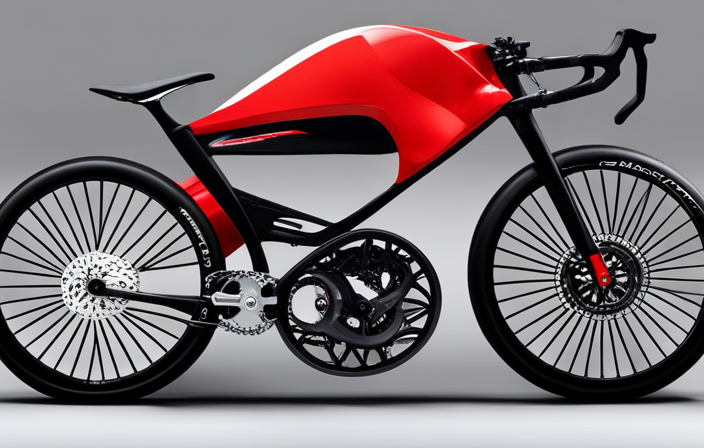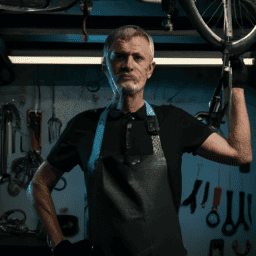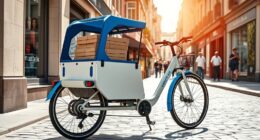As someone who is passionate about cycling, I understand the significance of securing reliable bike insurance. Regardless of whether you cycle occasionally, participate in races, or depend on your bicycle as your main form of travel, unforeseen accidents can occur. Consequently, it’s crucial to ensure you have appropriate insurance coverage to safeguard both you and your bicycle against any unforeseen incidents.
But with so many factors that can affect the cost of bicycle insurance, it can be challenging to know what to expect when shopping around for coverage. In this article, we’ll explore the different factors that can impact the price of bicycle insurance, as well as the average cost of coverage worldwide.
Additionally, we’ll discuss the different types of coverage available and provide tips on how to save money on your policy without sacrificing the level of protection you need. So, let’s dive in and take a closer look at how much you can expect to pay for bicycle insurance.
Key Takeaways
- Bicycle insurance cost varies based on factors such as bike value, rider age/experience, and storage location.
- Regions with higher population densities and bike thefts tend to have higher insurance rates.
- The types of coverage available include theft, accidental damage, and liability, with legal requirements for liability coverage varying by location.
- Strategies for saving on bicycle insurance include increasing deductibles, bundling with other policies, implementing security measures, and paying annually.
Factors that Affect the Cost of Bicycle Insurance
Factors that impact the cost of bicycle insurance can include the value of the bike, the rider’s age and experience, and the location where the bike will be stored.
Insurance providers will take into consideration the value of the bike, as more expensive bikes will require a higher premium. This is because the cost to replace a high-end bike is much greater than that of a lower-end model.
Additionally, a rider’s age and experience can impact the cost of the bicycle insurance premium. Younger, less experienced riders may be considered a higher risk and therefore may have a higher premium compared to older, more experienced riders.
The location where the bike will be stored can also affect the cost of the bicycle insurance premium. If the bike is stored in an area with a higher crime rate or is more prone to natural disasters, the insurance provider may charge a higher premium. This is because there is a higher likelihood of the bike being stolen or damaged in these areas.
Overall, it’s important to consider these factors when purchasing bicycle insurance to ensure that you’re getting the best coverage for your needs at a reasonable cost. Now let’s take a look at the average cost of bicycle insurance worldwide.
Average Cost of Bicycle Insurance Worldwide
You might be pleasantly surprised to find that protecting your trusty two-wheeled companion with insurance is like adding a cozy blanket to a chilly evening. The average worldwide price falls within a reasonable range, typically costing between $100 to $300 annually depending on the region and type of coverage selected. Regions with higher population densities and more bicycle thefts tend to have higher insurance rates.
Industry trends also play a role in determining the cost of bicycle insurance. As more people switch to cycling as a mode of transportation, insurance companies are seeing an increase in demand for bicycle insurance. This has led to a rise in competition among insurers, resulting in lower rates for policyholders. Additionally, some insurance companies offer discounts to policyholders who take safety courses or install anti-theft devices on their bicycles.
As you consider purchasing bicycle insurance for your beloved ride, it’s important to understand the types of coverage available.
Types of Coverage Available
When it comes to bicycle insurance, there are a few different types of coverage available. Personally, I’m interested in learning more about theft coverage, accidental damage coverage, and liability coverage.
These three areas seem especially important for anyone who relies on their bike for transportation or recreation.
Theft
Bikes are unfortunately a prime target for theft, so it’s important to consider adding theft coverage to your bicycle insurance. Here are three things to keep in mind when it comes to theft coverage:
-
Bike registration: Some insurance companies may require you to register your bike with a national database in order to be eligible for theft coverage. This helps to verify ownership in the event of a theft.
-
Reporting theft: It’s important to report any theft to the police as soon as possible, and to provide a copy of the police report to your insurance company. This will help to speed up the claims process.
-
Coverage limits: Make sure you understand the coverage limits of your theft coverage. Some policies may only cover a portion of the bike’s value, or may have a cap on the total amount that can be claimed.
Now, let’s move on to the next section about accidental damage.
Accidental Damage
If my bike experiences accidental damage, it can be frustrating and costly to repair or replace. That’s why having accidental damage coverage as part of my bicycle insurance policy is important.
This type of coverage can help cover the costs associated with repairing or replacing my bike if it’s damaged due to an accident, such as a crash or collision with another object.
When selecting my accidental damage coverage, I also need to consider my deductible options. A deductible is the amount of money I’m responsible for paying out of pocket before my insurance coverage kicks in.
Typically, the higher my deductible, the lower my monthly premium will be. However, if I choose a high deductible, I’ll need to be prepared to pay more out of pocket if my bike is damaged.
It’s important to carefully consider my budget and how much I can afford to pay in the event of an accident before selecting my deductible.
Moving on to the next section about liability, it’s important to consider the potential costs involved if I am found liable for injuring someone or damaging their property while riding my bike.
Liability
Previously, we discussed accidental damage coverage for bicycle insurance. Now, let’s shift our focus towards bicycle liability insurance. Liability coverage is a crucial aspect of protecting yourself and others while riding your bicycle. If you are involved in an accident, liability coverage can help cover the costs of damages and injuries to others involved.
It’s important to understand the legal requirements for bicycle liability insurance, as they may vary depending on where you live. In some states, liability insurance is mandatory, while in others it may only be required for certain types of riders or events. Regardless of the legal requirements, having liability coverage can provide peace of mind and financial protection in the event of an accident. Let’s take a closer look at what bicycle liability insurance covers and why it’s important.
| Type of Coverage | What it Covers | Why it’s Important |
|---|---|---|
| Bodily Injury Liability | Covers medical expenses for injuries to others caused by you while riding | Protects your assets and future earnings from being seized to pay for damages |
| Property Damage Liability | Covers damages to someone else’s property caused by you while riding | Protects your assets and future earnings from being seized to pay for damages |
| Uninsured/Underinsured Motorist | Covers medical expenses and damages if you are hit by a driver without insurance or with inadequate coverage | Provides financial protection in the event of an accident with an uninsured or underinsured driver |
Understanding the different types of liability coverage available and their importance can help you make an informed decision when choosing a bicycle insurance policy. However, it’s also important to consider how to save money on bicycle insurance. One way to do this is by increasing your deductible, which can lower your monthly premium. Another option is to bundle your bicycle insurance with other insurance policies, such as homeowner’s or renter’s insurance. By doing so, you may be eligible for a multi-policy discount.
How to Save Money on Bicycle Insurance
When it comes to saving money on bicycle insurance, there are a few strategies I’ve found to be effective.
First, investing in security measures like a sturdy lock or GPS tracker can often result in lowered premiums.
Additionally, bundling your bike insurance with your home or auto insurance can sometimes lead to discounts.
Finally, if you’re able to pay your premium annually rather than monthly, this can also help you save money in the long run.
Security Measures
One way to ensure peace of mind and protect your investment is by adding security measures to your bicycle. These measures can include a sturdy lock or GPS tracker, both of which can lower your bicycle insurance cost.
A bicycle lock is an essential security measure that can prevent theft. It’s important to invest in a sturdy lock that is difficult to break and has a high-security rating.
A GPS tracker is also a great security measure that can help you quickly locate your bike if it is stolen. With a GPS tracker, you can monitor the location of your bike in real-time and receive alerts if it moves without your permission.
Adding security measures to your bicycle not only protects your investment but can also lower your insurance cost. By reducing the risk of theft, you become a less risky customer to insure, and your insurance premium can decrease as a result.
However, security measures alone may not be enough to significantly lower your insurance cost. One additional way to save money on bicycle insurance is to bundle it with home or auto insurance. This bundling can lead to significant discounts and ultimately save you money.
Bundle with Home or Auto Insurance
You can save a significant amount on your insurance premiums by bundling your home or auto insurance with your bicycle insurance, but did you know there’s another benefit to this option? In addition to potential cost savings, bundling your insurance policies with the same provider can make managing your coverage much easier.
By having all of your policies in one place, you’ll have a better understanding of your coverage and be able to make changes or updates more efficiently. The benefits of bundling go beyond just saving money. It’s a convenient way to have all your insurance needs met in one place.
Plus, if you ever need to file a claim, you’ll only have to deal with one company, which can save you time and stress. Now that you know the benefits of bundling, let’s talk about another way to save money on your bicycle insurance premiums: annual payments.
Annual Payment
Paying for your bicycle insurance annually can be a smart financial move. Many insurance companies offer a discount on your overall premium if you pay for the coverage upfront for the whole year. This is a great way to save some money on your policy and avoid the hassle of monthly premiums.
To give you an idea of the potential savings, here’s a comparison table of annual vs. monthly premiums for bicycle insurance. Keep in mind that these rates are for illustrative purposes only, and your actual premiums will vary depending on factors such as your location, the value of your bike, and your coverage limits.
| Coverage | Annual Premium | Monthly Premium | Savings |
|---|---|---|---|
| Basic | $100 | $10 | $20 |
| Comprehensive | $200 | $20 | $40 |
| Premium | $300 | $30 | $60 |
When it comes to bicycle insurance, comparison shopping is key. Make sure to get quotes from several different insurance providers, both for annual and monthly payment options. This will help you find the most affordable coverage that meets your needs. In the next section, we’ll discuss how to choose the right bicycle insurance for you.
How to Choose the Right Bicycle Insurance
When it comes to protecting my trusty two-wheeled steed, finding the right bicycle insurance is like choosing the perfect helmet – essential for safety and peace of mind.
To choose the right bicycle insurance, it’s important to start by comparing policies. Look for policies that provide comprehensive coverage, including theft, damage, liability, and medical expenses. Make sure you understand the limits of coverage and any deductibles that may apply.
Another important factor to consider when choosing bicycle insurance is understanding exclusions. Exclusions are situations or circumstances that are not covered by the insurance policy. For example, some policies may not cover damage caused by racing or stunts, or may exclude coverage for certain types of bicycles.
It’s important to carefully review the policy and ask questions to ensure that you are aware of any exclusions that may apply. By taking the time to compare policies and understand exclusions, you can choose the right bicycle insurance to protect your bike and your peace of mind.
Frequently Asked Questions
What are the most common types of incidents that bicycle insurance covers?
Bicycle insurance commonly covers accidents and theft. It provides financial protection against loss or damage to your bike. Specific incidents covered may depend on the policy.
Is it possible to get bicycle insurance that also covers accidents while riding an electric bike?
Yes, it is possible to get bicycle insurance that covers accidents while riding an electric bike. However, it is important to note that there may be specific legal requirements and safety considerations for electric bikes.
How does the cost of bicycle insurance compare to other types of insurance, such as car or home insurance?
When comparing insurance benefits, bicycle insurance typically costs less than car or home insurance. However, this varies based on coverage options and individual factors. It’s important to weigh the cost of insurance against potential expenses in case of an accident or theft.
Are there any exclusions or limitations to coverage that I should be aware of before purchasing bicycle insurance?
Before purchasing bicycle insurance, it is important to be aware of any exclusions and limitations outlined in the fine print details. These can vary by policy and may affect coverage for certain types of damage or situations.
Can bicycle insurance also cover theft of accessories or components, such as a bike lock or GPS device?
Yes, bicycle insurance can cover theft of accessories such as bike locks and GPS devices. Some policies offer optional accident coverage for electric bikes. It’s important to review coverage limitations and exclusions before purchasing.
Conclusion
After researching the factors that affect the cost of bicycle insurance and the types of coverage available, I’ve come to the conclusion that the price of bicycle insurance can vary greatly depending on various factors such as the type and value of the bike, the location, and the level of coverage.
The average cost of bicycle insurance worldwide can range from $100 to $600 per year. However, there are ways to save money on bicycle insurance, such as opting for a lower level of coverage or bundling it with other insurance policies.
It’s important to choose the right bicycle insurance that meets your needs and budget. As the saying goes, "you get what you pay for,"so it’s essential to weigh the cost against the level of protection you need for your bike.









